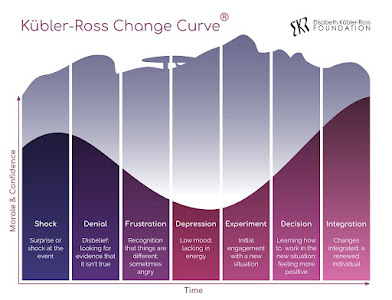Why business change means changing people....
And how to do that.
As the adage goes, “the only constant is change”.
We’ve seen massive global changes happen over the past 18 months. With
that, your customer’s needs are likely to have shifted significantly too. This
creates new demand for new types of services and products and new expectations
among customers of how they want those to be delivered.
There’s opportunity in that.
Companies that evolve to meet these needs are likely to be rewarded with
future growth. But, to evolve efficiently and effectively, businesses often need to
undergo a carefully managed process of change internally.
I have helped several organisations successfully achieve change, and I’m keen to share what I’ve learned along the way. In this blog post, I’ll dig into:
- What organisational change is and why it’s essential to manage it,
- How you can help your people navigate the necessary adjustments,
- What to do if you need any help in achieving your business change goals.
What is Business Change and Why Does It Need Managing?
Covid19 has rocked our world and forced many changes that none of us expected. However, there are also numerous other more predictable adjustments businesses have to make to remain relevant within their marketplace.
These could be due to outside influences like new legislation or new competition. Internal changes might also be needed due to updates to the business’s strategy, the introduction of innovations, an effort to resolve operational issues, or simply to support the success and growth of the business.
Expert on change, generational opportunities, and workforce trends, Karen McCullough explains, “Change in an organisation leads to many positive aspects that lead to retaining a competitive edge and also remaining relevant in your business area. Change encourages innovation, develops skills, develops staff and leads to better business opportunities and improves staff morale.”
Of course, practical changes often need to be
implemented to systems, processes, buildings, equipment, etc. But, over and above
those, successfully making changes to a company relies strongly on your people.
They need to understand why it is happening and be willing and able to help
make it happen. That’s where change management comes into play.
The ‘People’ Element of Change
Minor incremental changes happen in all businesses,
often daily. Your stakeholders will generally accept these without much
resistance. However, when it comes to major organisational changes, they may
find these hard to accept. Things like a business merger, the exit of a senior
leader, divestment, or downsizing, need careful management from a people
perspective.
For things to go smoothly, it’s crucial to consider the impact of such significant changes on your staff and others. Some critical questions to think about are:
- Do they fully understand the vision?
- Do they have the
information they need?
- What do they fear?
- What are they losing?
- What barriers do they feel exist to making the change?
- Do they have the opportunity to get involved and ask questions?
So, what’s the best way to answer these? How can
you encourage your team to support the changes you want or need to make?
How to Manage Change
It’s hardly surprising that the answer to managing change is change management. But what is it exactly, and how can you implement it?
According to change fanatics and advocates, Prosci, change management is “the discipline that guides how we prepare, equip and support individuals to successfully adopt change in order to drive organisational success and outcomes. Helping individuals through their individual change journeys enables organisations to:
- Address different impacts on people and teams,
- Deliver people-dependent ROI,
- Close the gap between requirements and results.”
Applying a structured change management process and
set of tools to support the people in your organisation can help move them from
their current condition to their own future state in a constructive way. The
Kubler-Ross change curve is one such tool.
The Kubler-Ross Change Curve
This model was originally developed to help people work through the various emotions experienced in relation to grief. When applied to business, it provides managers with a valuable framework for understanding what stage employees are at in terms of adapting to change. It’s also an excellent framework for getting internal change communications right.
Laura McHarrie, author of business resource blog The Hidden Edge, explains the application of the Kubler-Ross change curve by tying specific stakeholder needs and management actions to each stage of the curve, as follows.
Note that these stages come after the initial shock of hearing the news of the change and colleagues may move backwards and forwards along the curve over time.
1) Denial: needs alignment
To start with, create change conversations with your key team to explain the change or changes that are about to happen. Describe the vision, and make sure the ‘destination’ is clear, including what it means for those involved or impacted. For example, you could use a flip chart to write down who’s affected and what the benefits are. Have a feedback area next to each statement and let team members poke holes in them.
Everyone wants to know where they stand. So, when people are in denial, rather than spending time reassuring them that all will be OK, make current roles, timelines, and job responsibilities for all current projects clear.
2) Frustration:
needs maximum communication
When they’re frustrated, people need to be listened to. So, there’s no need to focus on creating a solid plan at this stage. It’s more important to be a listening ear and communicate as openly as possible without dismissing their frustrations. Address any rumours they might be hearing about the impending change and communicate possible timelines for organisational changes. It can be tempting to hold back information, but open communication is needed at this point. Informal conversations and honest dialogue can be used to maximise these communications.
3) Depression:
needs motivation to be sparked
When people are in depression, it’s best not to push performance feedback, reasons not to worry, or dismiss the feeling. Instead, focus on empathy and immediate motivation. This can be achieved through small wins that assure the person that their presence and views have value. Also, show your optimism that things will be OK and reinforce the benefits of the plan. Keep in mind that motivation isn’t all that’s needed. Sometimes people need to develop a capability before trying new practices.
4) Experimentation:
needs capability to be developed
People need time and opportunities to practice new skills. So, build slack time into your change timeline for when people are ready to experiment. Also, don’t back off at this stage. This is when you’re needed as a change agent to look for and enable innovation and collaboration. Then, maximise performance with both positive and critical feedback and move quickly into driving productive work.
5) Decision:
needs knowledge sharing
The business shouldn’t have to be reliant on your coaching or consulting skills throughout this change process. So, once people are fully on board with the change, get teams together to share their stories. Encourage people to work together, collaborate, learn from, and motivate each other.
Another element that I believe is essential to manage these is to implement and monitor, i.e. see what works and make tweaks to your
approach as you go. And, if you can see that things are moving off course,
don’t be afraid to reach out for help.
Need help?
We all know that change is inevitable, and it’s not always easy to do new things on your own.
I’ve managed hundreds of changes in business, from
small team changes to fundamental business transformations. I know what works
and what doesn’t. And I’m here to help you make changes in the most efficient
and effective ways possible for your company.
Why work with me?
I’m good at solving problems, creating solutions, and making change happen, and I also love learning about people and what makes them tick. So, helping people along the change curve comes naturally to me. Most importantly, I only work with clients who have a purpose and vision I believe in. Our shared values mean I become invested in making the changes you want to make, and you get my best work.
No matter the scale or scope of the organisational change you’re
planning, get in touch to find out how I can support you.




Comments
Post a Comment